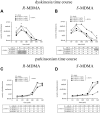Characterization of 3,4-methylenedioxymethamphetamine (MDMA) enantiomers in vitro and in the MPTP-lesioned primate: R-MDMA reduces severity of dyskinesia, whereas S-MDMA extends duration of ON-time
- PMID: 21562283
- PMCID: PMC6703214
- DOI: 10.1523/JNEUROSCI.1171-11.2011
Characterization of 3,4-methylenedioxymethamphetamine (MDMA) enantiomers in vitro and in the MPTP-lesioned primate: R-MDMA reduces severity of dyskinesia, whereas S-MDMA extends duration of ON-time
Abstract
l-3,4-dihydroxyphenylalanine (l-DOPA) is the most effective treatment for Parkinson's disease, but long-term l-DOPA administration is marred by the emergence of motor complications, namely, dyskinesia and a shortening of antiparkinsonian benefit (wearing-OFF). 3,4-methylenedioxymethamphetamine (MDMA) is unique in that it exerts antidyskinetic effects and may enhance antiparkinsonian actions of l-DOPA. MDMA is composed of two enantiomers with different pharmacological profiles; here, we describe a novel enantiospecific synthesis of the two enantiomers and expand on the previous characterization of their pharmacology. R-MDMA (rectus-MDMA) is relatively selective for 5-HT(2A) receptors, whereas S-MDMA (sinister-MDMA) inhibits both serotonin (SERT) and dopamine transporters (DAT; SERT/DAT ratio of 10 to 1). R- or S-MDMA (1, 3, and 10 mg/kg, s.c.) was administered in combination with l-DOPA (15 mg/kg, s.c.) to six female common marmosets (Callithrix jacchus) rendered parkinsonian by MPTP (1-methyl-4-phenyl-1,2,3,6-tetrahydropyridine) administration. Motor disability, including parkinsonism and dyskinesia, and duration of antiparkinsonian benefit (ON-time) were evaluated. After the administration of R-MDMA (3 and 10 mg/kg), the severity of peak-dose dyskinesia was decreased (by 33 and 46%, respectively; p < 0.05); although total ON-time was unchanged (approximately 220 min), the duration of ON-time with disabling dyskinesia was decreased by 90 min when compared to l-DOPA alone (69% reduction; p < 0.05). S-MDMA (1 mg/kg) increased the total ON-time by 88 min compared to l-DOPA alone (34% increase; p < 0.05), though dyskinesia were exacerbated. These data suggest that racemic MDMA exerts simultaneous effects, reducing dyskinesia and extending ON-time, by 5-HT(2A) antagonism and SERT-selective mixed monoamine uptake inhibition, which arise from its R and S enantiomers, respectively.
Figures






Similar articles
-
3,4-methylenedioxymethamphetamine (ecstasy) inhibits dyskinesia expression and normalizes motor activity in 1-methyl-4-phenyl-1,2,3,6-tetrahydropyridine-treated primates.J Neurosci. 2003 Oct 8;23(27):9107-15. doi: 10.1523/JNEUROSCI.23-27-09107.2003. J Neurosci. 2003. PMID: 14534244 Free PMC article.
-
UWA-121, a mixed dopamine and serotonin re-uptake inhibitor, enhances L-DOPA anti-parkinsonian action without worsening dyskinesia or psychosis-like behaviours in the MPTP-lesioned common marmoset.Neuropharmacology. 2014 Jul;82:76-87. doi: 10.1016/j.neuropharm.2014.01.012. Epub 2014 Jan 18. Neuropharmacology. 2014. PMID: 24447715
-
Trazodone alleviates both dyskinesia and psychosis in the parkinsonian marmoset model of Parkinson's disease.J Neural Transm (Vienna). 2018 Sep;125(9):1355-1360. doi: 10.1007/s00702-017-1830-8. Epub 2017 Dec 15. J Neural Transm (Vienna). 2018. PMID: 29247391
-
5-HT2A blockade for dyskinesia and psychosis in Parkinson's disease: is there a limit to the efficacy of this approach? A study in the MPTP-lesioned marmoset and a literature mini-review.Exp Brain Res. 2019 Feb;237(2):435-442. doi: 10.1007/s00221-018-5434-9. Epub 2018 Nov 15. Exp Brain Res. 2019. PMID: 30443669 Review.
-
The MPTP-treated primate as a model of motor complications in PD: primate model of motor complications.Neurology. 2003 Sep 23;61(6 Suppl 3):S4-11. doi: 10.1212/wnl.61.6_suppl_3.s4. Neurology. 2003. PMID: 14504374 Review.
Cited by
-
Effect of the mGlu4 positive allosteric modulator ADX-88178 on parkinsonism, psychosis-like behaviours and dyskinesia in the MPTP-lesioned marmoset.Psychopharmacology (Berl). 2023 Oct;240(10):2093-2099. doi: 10.1007/s00213-023-06428-1. Epub 2023 Jul 29. Psychopharmacology (Berl). 2023. PMID: 37516708
-
Dopamine and serotonin modulation of motor and non-motor functions of the non-human primate striato-pallidal circuits in normal and pathological states.J Neural Transm (Vienna). 2018 Mar;125(3):485-500. doi: 10.1007/s00702-017-1693-z. Epub 2017 Feb 7. J Neural Transm (Vienna). 2018. PMID: 28176009 Review.
-
Balancing Therapeutic Efficacy and Safety of MDMA and Novel MDXX Analogues as Novel Treatments for Autism Spectrum Disorder.Psychedelic Med (New Rochelle). 2023 Sep 13;1(3):166-185. doi: 10.1089/psymed.2023.0023. eCollection 2023 Sep. Psychedelic Med (New Rochelle). 2023. PMID: 40046567 Free PMC article. Review.
-
Combined mGlu2 orthosteric stimulation and positive allosteric modulation alleviates L-DOPA-induced psychosis-like behaviours and dyskinesia in the parkinsonian marmoset.J Neural Transm (Vienna). 2020 Jul;127(7):1023-1029. doi: 10.1007/s00702-020-02185-z. Epub 2020 Apr 3. J Neural Transm (Vienna). 2020. PMID: 32246204
-
Serotonergic targets for the treatment of L-DOPA-induced dyskinesia.J Neural Transm (Vienna). 2018 Aug;125(8):1203-1216. doi: 10.1007/s00702-017-1837-1. Epub 2018 Jan 5. J Neural Transm (Vienna). 2018. PMID: 29305656 Review.
References
-
- Aghajanian GK, Marek GJ. Serotonin induces excitatory postsynaptic potentials in apical dendrites of neocortical pyramidal cells. Neuropharmacology. 1997;36:589–599. - PubMed
-
- Ballanger B, Strafella AP, van Eimeren T, Zurowski M, Rusjan PM, Houle S, Fox SH. Serotonin 2A receptors and visual hallucinations in Parkinson disease. Arch Neurol. 2010;67:416–421. - PubMed
-
- Battaglia G, Brooks BP, Kulsakdinun C, De Souza EB. Pharmacologic profile of MDMA (3,4-methylenedioxymethamphetamine) at various brain recognition sites. Eur J Pharmacol. 1988;149:159–163. - PubMed
-
- BBC. Ecstasy & agony. 2001. Retrieved January 27, 2011. http://www.bbc.co.uk/science/horizon/2000/ecstasyagony.shtml.
Publication types
MeSH terms
Substances
LinkOut - more resources
Full Text Sources
Other Literature Sources
Medical
Miscellaneous
